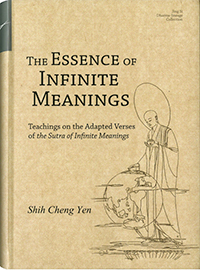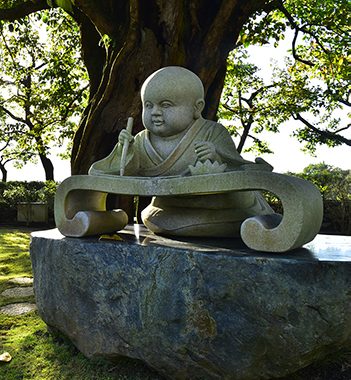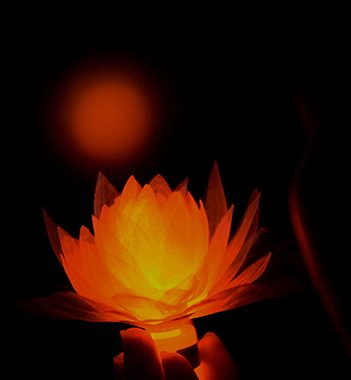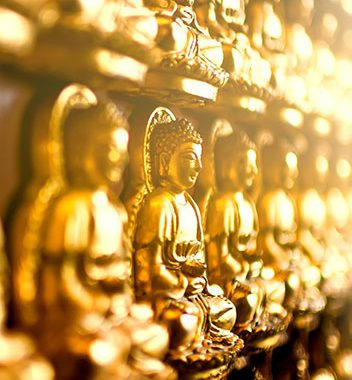In Sanskrit, the Sutra of Infinite Meanings (also known as the Sutra of Innumerable Meanings) is called the Amitarthasutra. This sutra is one volume comprised of three chapters: the Chapter on Virtues, the Chapter on Expounding the Dharma, and the Chapter on the Ten Merits. Together with the Wondrous Dharma Lotus Flower Sutra and the Sutra of Meditation on Samantabhadra Bodhisattva, they form the Threefold Lotus Sutra. Before expounding the True Dharma of the Wondrous Dharma Lotus Flower Sutra, the Buddha first taught the Sutra of Infinite Meanings in the hopes that everyone in the state of unenlightened beings could develop great compassion and reach the Bodhisattva Path. This message of compassion and the Bodhisattva Path make this sutra especially relevant to Tzu Chi’s missions, and its teachings are infused in the Jing Si Dharma Lineage and the Tzu Chi School of Buddhism.
Master Cheng Yen’s affinity with the Sutra of Infinite Meanings dates back to 1960, during her travels with Dharma Master Xiu Dao. On a bookshelf in Taitung, she spotted a Japanese copy of Lectures on the Lotus Sutra for the first time and felt a great affinity with the Sutra of Infinite Meanings. Beginning in 1972, the Jing Si Abode organized a series of seven-day Buddhist retreats to teach the Sutra of Infinite Meanings. Unable to find any copies of this sutra in local bookstores, Master Cheng Yen carved the sutra onto steel plates for printing in order to provide a copy to all participants. Since then, the Sutra of Infinite Meanings has become an important source of teachings for Master Cheng Yen’s disciples. She frequently cites the verse, “With minds tranquil and clear, vows vast as the universe, Bodhisattvas remain unwavering for countless kalpas. Infinite Dharma doors readily appear in front of them. They attain great wisdom and thoroughly comprehend all Dharma,” as the foundation of the Jing Si Dharma Lineage and the Tzu Chi School of Buddhism. In the period of 1972 to 2016, Master Cheng Yen quoted this sutra more than 2,000 times, using current events and Tzu Chi stories to illustrate its principles.
In Sanskrit, the Sutra of Infinite Meanings (also known as the Sutra of Innumerable Meanings) is called the Amitarthasutra. This sutra is one volume comprised of three chapters: the “Chapter on Virtues,” the “Chapter on Expounding the Dharma,” and the “Chapter on the Ten Merits.” During the Southern Qi Dynasty, Tripitaka Sramana Dharmagatayasas from India translated the sutra and introduced it to China. This sutra, the Wondrous Dharma Lotus Flower Sutra, and the Sutra Expounded by the Buddha on the Contemplation Practice of Samantabhadra Bodhisattva are together called the Threefold Lotus Sutra.
The Sutra of Infinite Meanings is the introductory sutra in the Threefold Lotus Sutra, and it represents the pivotal teaching for opening up the Buddha’s provisional teachings to reveal the true Dharma. During the previous forty years, the Buddha had taught the Dharma using all kinds of skillful means, but he had not yet revealed the truth of the Dharma until he taught the Wondrous Dharma Lotus Flower Sutra. Before teaching the Wondrous Dharma Lotus Flower Sutra, he first taught the Sutra of Infinite Meanings. This can be seen in the “Introductory Chapter” of the Lotus Sutra, which states, “For the sake of all bodhisattvas, he expounded the Great Vehicle Sutra known as the Sutra of Infinite Meanings and taught the Bodhisattva Way.” Sentient beings have infinite desires, so the Buddha taught infinite Dharma with infinite meanings. However, these infinite meanings come from one Dharma, and this one Dharma is the nature of non-appearance, the nature of emptiness that is intrinsic to everything.
The main purpose of the Sutra of Infinite Meanings is to elucidate the teaching of infinite meanings. The Buddha wanted to teach sentient beings to walk the Bodhisattva Path and to eliminate their attachment to self. He wanted to help all beings realize that all phenomena are inherently pure, neither arising nor ceasing, and that they are impartial, empty, and still. As this sutra says, “This sutra comes from the royal home of all buddhas, goes to where sentient beings develop Bodhicitta, and abides wherever bodhisattvas practice.” It is the Buddha’s hope that all sentient beings in an unenlightened state can give rise to great compassion and walk the Bodhisattva Path.
Dharma Master Cheng Yen’s First Encounter with the Sutra of Infinite Meanings
Master Cheng Yen’s affinity with the Sutra of Infinite Meanings began before she became a monastic. In 1960, Master Cheng Yen, then known as Wang Jinyun, went with Master Xiu Dao to the Lotus Community in Taitung to give Dharma lectures. Mr. Wang, chief of the general affairs department at Malan Sugar Factory, and his wife were Buddhists. They invited Master Xiu Dao and Master Cheng Yen to their home. There, on Mr. Wang’s bookshelf, Master Cheng Yen saw a Japanese copy of Lectures on the Lotus Sutra by Ichiro Kobayashi.
Master Cheng Yen picked up the first volume, the Sutra of Infinite Meanings, and after reading it, she was greatly moved. She felt especially joyous when she encountered the words, “With minds tranquil and clear, vows vast as the universe, they remain unwavering for countless kalpas.” She began to understand that ultimately, the Buddha Dharma is about our daily living, and bodhisattvas actually live in this world. If people can achieve the state described in the sutra, they would be living bodhisattvas. Unfortunately, at the time, Dharma Master Cheng Yen did not have the means to purchase sutras, so she could only copy the Sutra of Infinite Meanings word by word with a calligraphy brush. Later, the Dharma masters at the Jing Si Abode bound the manuscript into a book and circulated it. This manuscript version has become the most highly treasured work of calligraphy for Tzu Chi volunteers worldwide.
After Dharma Master Cheng Yen was ordained and became a monastic, she asked someone to bring a copy of the New Commentary on the Threefold Lotus Sutra from Japan. In her small wooden cabin, she prostrated to, recited, and copied the Lotus Sutra. During her recitations and prostrations, she experienced a state of tranquility and clarity like that described in the Sutra of Infinite Meanings. Master Cheng Yen became determined to actualize the concept of “Living Bodhisattvas”. As she said, “Mindfully studying the meaning of the sutra led me to understand the spirit of the buddhas and bodhisattvas in this world. This made me even more determined to put the Buddha Dharma into practical use.”
The Seven-Day Buddhist Retreat of the Sutra of Infinite Meanings
In 1966, Buddhist Difficulty-Overcoming Tzu Chi Merit Association was established at Puming Temple. In the third lunar month of 1969, the Jing Si Abode’s prayer hall was opened for use, and a seven-day Buddhist retreat was held. Following this, a seven-day Buddhist retreat was then held each year before the anniversary of the Tzu Chi Merit Association. This continued until 1989, when the space at the Jing Si Abode was not sufficient to accommodate all of the participants. Furthermore, by this time, the Hualien Tzu Chi Hospital had begun operations and Tzu Chi Nursing School had been established. So, for these and other reasons, the seven-day Buddhist retreat was temporarily suspended.
In 1972, a seven-day Buddhist retreat was held to teach the Sutra of Infinite Meanings. However, the Sutra of Infinite Meanings is very profound, so there was no way to finish teaching the entire sutra in its full length in one retreat. Therefore, in 1972 and 1973, Tzu Chi held seven-day Buddhist retreats for the Sutra of Infinite Meanings from the eighteenth to the twenty-fourth day of the third lunar month for two years in a row.
Master Cheng Yen recalled that when the seven-day Buddhist retreat was held, some lay practitioners even made a special trip from Taipei to participate. There were also practitioners from Hualien county, Hualien city, Yuli Township, and Ruisui Township who also made time to attend. Although there were only a dozen or so people, they filled up the small prayer hall. Master Cheng Yen hoped that there would be more and more participants in the seven-day Buddhist retreat each year so that the Buddha Dharma could be spread more widely. In the past, people did not know what to do in a seven-day Buddhist retreat or how to pay their respect to the Buddha. It took several retreats before everyone gradually understood the meaning of chanting the Buddha’s name and the merits of attending a seven-day Buddhist retreat.
At the time, the Jing Si Abode was very small. Some people laughed and said, “Master, this year we are already out of room for everyone to sit down, yet you hope for even more people to attend next year? What should we do then?” Master Cheng Yen replied, “The Buddha Dharma is infinite. Do not be afraid to come next year just because there is not enough room for more people to sit or sleep this year. Do not worry. I am sure that however many people come, we will still be able to accommodate them.” With faith, determination, and courage, Master Cheng Yen wanted to spread the Buddha Dharma to the heart of every Buddhist practitioner, enabling everyone to engage in spiritual practice together, to uphold the Dharma, and to receive its benefits.
During the early period, the daily life of the Dharma masters at the Abode was very difficult. They wanted to recite the Sutra of Infinite Meanings but did not have the money to buy a copy. Also, at that time, many people had never heard of the Sutra of Infinite Meanings, so those attending the seven-day retreat did not know where to purchase a copy of it. Dharma Master Cheng Yen wrote a letter of inquiry to Ruicheng Bookstore in Taichung and found that in Taiwan, there were no published copies of just the Sutra of Infinite Meanings in circulation. The only way she could provide copies to everyone was to transcribe the sutra by hand from the Japanese publication A Modern Interpretation of the Threefold Lotus Sutra by Nikkyo Niwano. Using a steel pen and engraving each character, stroke by stroke, on a steel plate, Master Cheng Yen slowly transcribed the entire Sutra of Infinite Meanings, even injuring her hand in the engraving process. She then produced copies using wax paper, which she provided to everyone in the assembly for recitation. Up to this day, the Jing Si Abode has still preserved that hand-engraved copy of The Sutra of Infinite Meanings.
Master Cheng Yen once pointed to her own hand and explained, “I exerted my hand so forcefully in engraving on that hard steel plate that I injured my fingers. Even now when my hand is in a certain position, it will throb with pain. Early Tzu Chi magazines were also engraved and printed using a steel plate. We had to press hard to inscribe each character into the steel. In those years, all the recitation booklets used at the Jing Si Abode were printed from hand-carved steel plates and then carefully folded page by page into sutra booklets. Some of the recitation copies of the Sutra of Infinite Meanings used by the Dharma masters today are reprints of that first handmade version.”
Master Cheng Yen not only used a calligraphy brush to copy the Sutra of Infinite Meanings, but she even engraved it on a steel plate to be printed. In this way, not only did she copy it, but she also put the Dharma essence of the Sutra of Infinite Meanings into practice with her actions. Of the original hand-engraved copies of the Sutra of Infinite Meanings and the booklets used in the Jing Si Abode’s morning recitations, only seven copies remain. To preserve Master Cheng Yen’s manuscript, as well as to express gratitude to the Buddha and to Master Cheng Yen, the disciples at the Jing Si Abode converted the engravings into a digital file and reprinted the booklets for Tzu Chi’s fiftieth anniversary.
During the seven-day Buddhist retreat in 1972, Master Cheng Yen taught in three sessions each day and explained the sutra in detail, hoping that those who heard would truly understand the principles of the Buddha’s teachings. When Master Cheng Yen spoke, she used her utmost energy and strength to lead the assembly. Thus, inspired by Master Cheng Yen’s enthusiasm, everyone put effort into upholding a proper demeanor and dignified conduct so that those seven days were not spent in vain.
Every year, on the last day of the seven-day Buddhist retreat, a distribution to care recipients was held during the day, and a ritual for feeding hungry ghosts was held during the evening. Because of these events, Master Cheng Yen was unable to explain the sutra passages in detail. Furthermore, if the passages were not closely related to everyday living, she would simply read them over. In the last two sections in the “Chapter on Virtues” or the “Chapter on the Ten Merits,” for example, Master Cheng Yen used a very simple method of explanation. In this newly-edited publication, in order to retain the sentiment and historical record of the seven-day Buddhist retreat, that section is also left as it was explained. No new content has been added to this compiled publication.
Tzu Chi Merit Association and Merit Trees
The affinities between the Sutra of Infinite Meanings and the Tzu Chi Merit Association are truly inconceivable. When Master Cheng Yen established the Tzu Chi Merit Association and chose “Merit Association” as its name, she had not heard anyone teach the Sutra of Infinite Meanings. This sutra particularly emphasizes that there are ten inconceivable merits that result from practicing according to its teachings. The power of these merits can lead bodhisattvas who have not given rise to bodhicitta to do so. As the sutra states, these merits “enable all sentient beings who are still in an unenlightened state to sprout forth the infinite aspirations of all bodhisattvas and cause trees of merit to flourish and grow.”
The essence of this sutra and Tzu Chi’s goals are very much in accord. The concept of trees of merit, and the Tzu Chi tree in particular, are very compatible, as both validate the sutra’s statement that “one gives rise to infinity and infinity arises from one.” Tzu Chi volunteer’s compassion, wisdom, vows, and actions to save sentient beings also cause trees of merit to gradually flourish and grow strong.
In this sense, the meaning of Tzu Chi is inseparable from the teachings in the Sutra of Infinite Meanings, and the principles in the Sutra of Infinite Meanings is the spirit that Tzu Chi seeks to spread.
The Sutra of Infinite Meanings and the Jing Si Dharma Essence
The Sutra of Infinite Meanings became the essential Dharma-treasury that Tzu Chi follows, as stated in the motto, “The Jing Si Dharma-lineage is a path of diligent practice. The Tzu Chi School is a way of bodhisattvas in the world.” For many years, when Master Cheng Yen gives her Wisdom at Dawn Dharma lectures or speaks in closing ceremonies of retreats and lectures, she often refers to the passages of the Sutra of Infinite Meanings, and she has used current affairs of the world and stories from Tzu Chi to explain its meaning and principles. When Tzu Chi’s archives were reviewed between 1972 to 2016, there were over 2,000 records of Master Cheng Yen quoting the Sutra of Infinite Meanings. Additionally, in conversations with her disciples and visitors, she has referred to the sutra passages countless times. From the content of her teachings, we can see that, although the world has continued to change throughout the years, Master Cheng Yen has never stopped advancing the Bodhisattva Path.
There are a few particularly clear examples of this. In her Wisdom at Dawn Dharma lectures, when Master Cheng Yen taught the “Dharma as Water” series from April 2003 to March 2008, she relied heavily on the teachings and passages of the Sutra of Infinite Meanings to interpret the Compassionate Samadhi Water Repentance.
In December 2016, at Tzu Chi’s Four Missions staff conference, Master Cheng Yen clearly revealed during her lecture that the passage, “with minds tranquil and clear, vows vast as the universe, we remain unwavering for countless kalpas” forms the Dharma essence for passing on the Jing Si Dharma-lineage. Likewise, the passage, “Infinite Dharma doors readily appear before us; we attain great wisdom and completely understand all Dharma,” forms the foundation for advancing the Tzu Chi School of Buddhism.
In 2007, Wang Tuan-Cheng adapted passages from the Sutra of Infinite Meanings into lyrics for the Adapted Verses of the Sutra of Infinite Meanings. Afterward, Tzu Chi Faith Corps members, commissioners, and staff of the Four Missions collaborated and presented the musical adaptation Purity, Great Love, Infinite Meanings based on the Sutra of Infinite Meanings. Through sign language, singing, movement, and more, they presented the essential meanings of this sutra. They toured Taiwan to perform this musical adaptation, receiving wide acclaim.
From March 2008 to January 2009, in her early morning Dharma talk, Master Cheng Yen explained the adapted verses of the Sutra of Infinite Meanings word by word, supplemented by verses she wrote on her own. In this way, she even further expounded the teachings of the Sutra of Infinite Meanings. At this point, the Dharma essence and spirit of the Bodhisattva Path contained within the Sutra of Infinite Meanings have been etched into the minds and memories of lay and monastic Jing Si disciples. Tzu Chi volunteers do not only keep these teachings in mind, but also put them into practice. They take the Dharma to heart and put it into action, widely practicing the Bodhisattva Path around the world.
The Sutra of Infinite Meanings and Tzu Chi’s Four Missions
The Sutra of Infinite Meanings includes the metaphor of a seed. As Master Cheng Yen continues to teach, those who follow the Bodhisattva Path sprout across the world. Millions of Living Bodhisattvas grow in turn and continue in this way without limit. Master Cheng Yen has exercised loving-kindness and compassion to establish Tzu Chi’s four missions and eight footprints according to sentient beings’ needs, to put the spirit of the Sutra of Infinite Meanings into practice, and to establish the teachings for all to walk the Bodhisattva Path.
Master has said that the phrase, “…tranquil and clear, vows as vast as the universe, they remain unwavering for countless kalpas” appears in her mind every day, and the work of Tzu Chi is done according to these words. As long as these words can be put into practice, attaining buddhahood will not be difficult!
Preserving Master’s Teachings with Faith, Steadfastness, Sincerity, and Integrity
This book is compiled from the teachings expounded during the seven-day Buddhist retreats in 1972 and 1973. Those retreats were held at the sixth and seventh anniversaries of the Tzu Chi Merit Association, before Tzu Chi’s four missions had been fully established. At that time, Tzu Chi was mainly focusing on charity projects and visiting the poor as ways to walk the Bodhisattva Path. Master Cheng Yen explained the sutra word by word, verse by verse, and complemented it with many analogies and real-life stories, connecting matters to principles. In her teachings, Master Cheng Yen continually emphasized that the significance of Tzu Chi is inseparable from the Sutra of Infinite Meanings. The Sutra of Infinite Meanings is the spirit that Tzu Chi must practice. She repeatedly explained the meaning behind fundraising and visiting the poor so that people attending the retreat could further understand how to cultivate their bodies and minds, thus learning and diligently practicing the Bodhisattva spirit.
The book is organized as follows: The background of the teachings and Master Cheng Yen’s karmic affinity with the Sutra of Infinite Meanings are explained in the Preface. The “Chapter on Virtues,” “Chapter on Expounding the Dharma,” and “Chapter on the Ten Merits” of the sutra are explained each in its own chapter. As for the last passage in the “Chapter on Ten Merits,” from the line “Enable all sentient beings to see and hear it, read and recite it, transcribe it, make offerings” to “At this time, all in the assembly rejoice. They paid their respect to the Buddha, accepted and upheld the teachings as they departed,” the audio tape of Master Cheng Yen’s teaching on this section has been lost. Therefore, only the sutra passages have been kept without any additions.
The sutra version used here is the copy of Master Cheng Yen’s manuscript (printed by the Jing Si Abode in 2011). Although some of the wording is different from that found in the more common Da Zheng Chinese Buddhist Canon, the meaning is the same. Through use of Master Cheng Yen’s manuscript, we preserve not only the sutra’s content but also Master Cheng Yen’s original word choice.
The editorial team abides by the principles of faithfulness, comprehension, and elegance. We follow Master Cheng Yen’s sequence of ideas and her tone of teaching so as to be faithful to her teachings and to the context. We have preserved the meanings, principles, and the flow of the words so that they are clear and easy to understand, and we have focused on the elegance of the writing so that the reader may find the teachings readable and enjoyable.
The writing on the cover is based on Master Cheng Yen’s calligraphy when she first transcribed the Sutra of Infinite Meanings and the Wondrous Lotus Sutra by hand. The inclusion of the words “teachings and commentary” in the book title represents how, while Master expounds the sutra, she makes use of events from the past to the present, across the long river of time. This affirms that “all buddhas share the same path”; the teachings are just as relevant to modern living as they were when Sakyamuni Buddha originally taught them. The word choice is modern, while also retaining the usages of many ancient words. Part of the teachings also contain original terms created by Master Cheng Yen, which differ from more common expressions, yet can explain the sutra’s key meanings even more thoroughly.
The original Chinese publication of this book was made possible by the Jing Si Abode’s monastic practitioners, Pure Practitioners, Tzu Chi volunteers, and others. A total of more than 130 participants helped to transcribe, proofread, and compile the content from the original audio recordings.
After editing, in pursuit of the utmost circumspection and reverence for the teachings, we requested volunteers and masters at the Jing Si Abode to read the transcription, and to give feedback on the matters and principles contained within, as well as any doubts they may have had as they read it. We finalized the draft only after repeated discussions and amendments.
For the Chinese version, designer Chen Jun-Liang’s team from Freeimage Design helped with the cover and proposed a text layout where each verse can inspire silent contemplation and each paragraph can stand on its own, while together they form an entire chapter. This design allows the Buddhist sutra to suit modern Chinese reading habits and to be more deeply integrated into our contemplation of daily living.[1]
Department of Dharma and History Compilation
Jing Si Abode, September 2016





